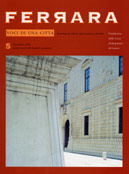All you have to do is run through the index of artists' names, that of place names and those of remarkable things, as well as the index of sources and you will understand the boundless scope of the work that goes beyond the history of art in the strictest sense of the term to embrace the most diverse human activities and thus provide us with a precious and rigorously documented insight into what might be called a cultural itinerary.
If one reflects on the significance of the influence of Ferrara and the Este family on Italian and European art in the climate of Humanism and the Renaissance, the fundamental importance of this work emerges even more clearly, so much so that it must now be considered the point of departure for anyone intending to further his knowledge of this sector.
Nor should we underestimate the importance of the chance to rectify or even overturn the paternity of paintings until today attributed on the sole basis of merely aesthetic or stylistic considerations, now that we have documents that banish all doubts with the certainty of irrefutable data.
A propos of this, Ferrara must be aware of the contribution to its cultural heritage made by a man who has kept faith with rigorous standards of research, dedicated study, and continuous and tireless activity under the least favourable or even, sometimes, extremely difficult conditions.
And we ought to ask ourselves if enough thought has been given to the merits of a person who, practically self taught, has acquired such a profound knowledge of history, such a competence in paleography, and a methodology of such refinement that he is continually approached for opinions, help and consultation by eminent scholars, illustrious university professors and famous academics the world over.



